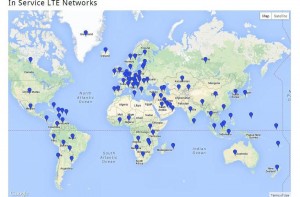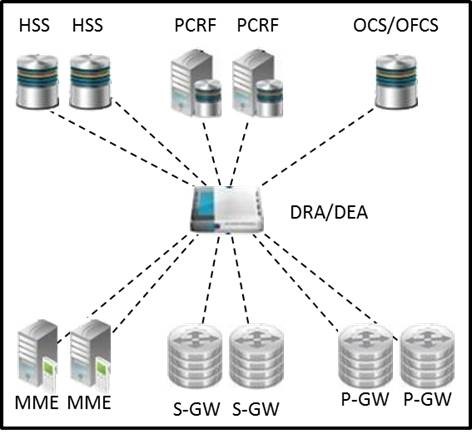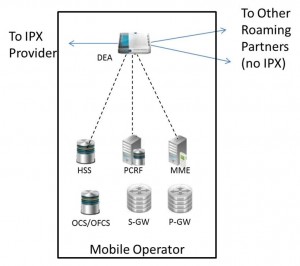As LTE roaming quickly becomes a reality, there is a need for an edge device (Diameter edge agent) to concentrate multiple IP connections between IPX’s and roaming partners as well as to provide security and topology hiding.
The LTE landscape
According to the GSMA, LTE is now moving to a more mature phase of development with around 230 commercial LTE networks now in operation in 88 countries and over one billion connections expected by 2017.

LTE Deployments and Commitments (LteMaps.org, January 23, 2014)
Until recently, LTE roaming has been limited to trials between operators with aligned frequencies. According to the GSMA, LTE networks worldwide have been deployed in 12 different frequency bands to date, although four out of five live LTE networks today are deployed in one of four bands: 700 MHz, 800 MHz, 1800 MHz or 2600 MHz. Despite the prevalence of LTE phones, they still “fall back” to 3G technologies for roaming. This inhibitor to roaming is beginning to change. A number of mobile devices are now available that use Qualcomm’s Snapdragon chipset. These devices support multiple bands in use by multiple operators allowing their subscribers to roam on other operator’s LTE networks with the proper 3G fall back when necessary.
LTE roaming and Diameter signaling control
The majority of mobile network operators have not deployed a Diameter signaling controller solution. The signaling between LTE network elements has been handled primarily by point-to-point connections. However, operators have recognized that the point-to-point model does not scale when you have multiple instances of network elements.
Early Diameter routing deployments fell into two general categories:
Protocol translation/Interworking: Translation functions to facilitate communication between network elements (e.g. Release 5 to-from Release 6, different interpretations of the specification by two vendors, of SS7 to Diameter translation, etc.).
Providing load balanced routing for multiple instances of home subscriber server databases, policy servers or billing systems, etc.
Tier-one LTE mobile operators with multiple instances of network elements embraced the need for Diameter routing controllers for the management of their core intra-network traffic. Beginning in 2012, inter-operator services (IPX providers) started to procure DSCs in advance of LTE roaming.
As LTE continues to grow, the DSC market has expanded to include DEA functionality. Most mobile network operators do not have multiple instances of EPC elements and do not require a Diameter routing agent. However for LTE roaming, EPC network elements in a mobile operator’s network will need to connect to the corresponding network elements in a partner mobile operator’s network, through a Hosted DRA/DEA service of an IPX provider, or a combination of the two. This will require multiple secure IP connections.
If the mobile network operator connects to more than one IPX or if it connects directly to other operators, these connections will have to be duplicated for each one. If the mobile network operator has an on-site DEA, only one connection is required for each IPX or direct connection to other operators (local breakout). The DEA also provides topology hiding to protect the network elements and addresses from being exposed to foreign networks (analogous to the NAT function of IP routers).
Operators now recognize the need for DSCs and the cycle has moved from a post-LTE deployment afterthought into the planning stage of the mobile operator’s LTE deployment cycle.
The market will evolve to support five general categories:
Each category can exhibit its own deployment cycle. For example, in the protocol translation/interworking category, the cycle can be extremely short as the need occurs when a mobile operator recognizes an incompatibility. While early sales of DSCs typically occurred after LTE deployment, we are now seeing mobile operators incorporate this into their planning – especially in the areas of legacy internetworking, load balancing and inter-core traffic routing. The deployment of DEAs will intensify once LTE roaming becomes common.
The standards bodies thought through the various LTE deployment scenarios and developed standards that the DSC is based on. As LTE was rolled out around the world each of the defined functions have been needed. The DEA is one of the last to be needed, yet it will be required by almost all operators.
The DEA function also lends itself very well to virtualization. Both IPX providers and mobile network operators can benefit from an on-demand cloud-based DES. By introducing on-demand DEA signaling service, the IPX provider can offer guaranteed SLA for end-to-end LTE roaming, high scalability and interconnection service to their roaming partners and end users. When the mobile network operator inter-connects with a new IPX provider, the DEA must provide high signaling performance, scalability and routing, so the mobile operator can scale up the Diameter signaling capacity by instantiating a new virtual DEA function on-demand. Virtualized services are expected to lower the overall total cost of LTE roaming.
Conclusion
Despite incompatible spectrum, LTE roaming is becoming a reality. Along with it there is a demonstrable need for a DEA to concentrate multiple IP connections between IPX’s and roaming partners as well as to provide security and topology hiding. The DEA can be positioned at the IPX or roaming hub, but more likely each mobile network operator will require the functionality at the edge of its network. Not only can the DEA function be virtualized in the cloud, it may be one of the earliest LTE functions to do so.







